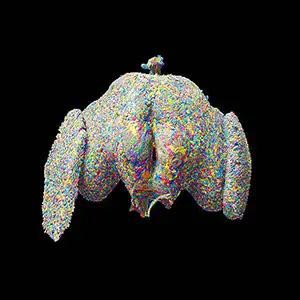
First complete map created of every neuron in an adult brain
Imagine gazing at the intricate yet beautiful map of an entire city, but the city is in fact a brain. Sounds fascinating, doesn’t it? Well, scientists have now made this a reality.
Experts have created the first-ever wiring diagram, or “connectome,” of every neuron in an adult brain along with the 50 million connections between them, marking a milestone in the field of neuroscience.
Complete wiring diagram of the brain
The project was made possible by the FlyWire Consortium, a large international collaboration involving scientists from the MRC Laboratory of Molecular Biology in Cambridge, Princeton University, the University of Vermont, and the University of Cambridge.
The research, which is published in a pair of papers in the journal Nature, delivers the first complete wiring diagram of all 139,255 neurons in an adult fly brain — an animal capable of both walking and seeing.
Previous studies have mapped smaller brain systems like fruit fly larva with 3,016 neurons, or the nematode worm with 302 neurons.
However, the current study breaks new ground by offering a full-scale neural map for a more complex organism.
Human brains vs. fly brains
Mapping every neuron in an adult fruit fly brain is a key step in understanding how brains function, including our own.
Fruit flies have about 140,000 neurons, which is a tiny number compared to the 86 billion in the human brain, making them much easier to study.
Scientists can quickly breed and tweak fruit flies, allowing them to play around with genetics and see how changes affect neural circuits and behavior.
This simplicity helps researchers uncover the basic principles of brain function without getting bogged down by too much complexity.
Brain maps provide human brain insights
Interestingly, many biological processes in fruit flies are pretty similar to those in humans. The genes and pathways that control brain development, neuron communication, and learning are often conserved across species.
By mapping the fruit fly brain, scientists can figure out how these processes work in a simpler system and then apply those insights to more complex brains.
Plus, understanding how neurons connect in flies reveals general patterns of neural circuit organization and behavior, which can help us understand human behaviors and cognitive functions too.
Finally, the tools and techniques developed for mapping the fruit fly brain set the stage for breakthroughs in neuroscience research. Innovations in imaging, genetic manipulation, and data analysis from fruit fly studies can be adapted for studying more complex brains, including our own.
Also, insights from fruit flies can help model neurological diseases and developmental disorders, leading to potential therapies for humans.
Ongoing research in neuroscience
The findings offer valuable insights into brain structure and function, providing a vital comparison for ongoing research in neuroscience.

“If we want to understand how the brain works, we need a mechanistic understanding of how all the neurons fit together and let you think. For most brains, we have no idea how these networks function,” noted study co-author Dr. Gregory Jefferis.
The detailed map of the fly’s brain could answer many of these questions, unlocking the intricacies of neural circuits.
Similarities in brain wiring
One of the most remarkable revelations of the study is the substantial similarities in the wiring that were found between the current map and previous smaller-scale efforts.
This has led to the conclusion that individual brains share inherent similarities in their wiring – contrary to the belief that each brain is a unique structure.
Journey to mapping the brain
The path to this achievement involved slicing a whole fly brain, which measures less than a millimeter wide, into 7,000 thin slices.
These slices were then meticulously scanned using high-resolution electron microscopy to extract the shapes of approximately 140,000 neurons and 50 million connections between them.
Power of artificial intelligence
The task of analyzing this enormous amount of data was made possible using machine learning, demonstrating the potential for AI technology to revolutionize neuroscience.
Ensuring the accuracy of the data required an estimated 33 person-years for proofreading. Despite the challenges, the outcome of this meticulous endeavor has paved the way for future revelations in neuroscience.

Beyond just establishing the neuronal connections, the researchers also interpreted many details of the wiring diagram – such as classifying more than 8,000 cell types across the brain.
“This dataset is a bit like Google Maps but for brains: the raw wiring diagram between neurons is like knowing which structures on satellite images of the Earth correspond to streets and buildings,” explained Dr. Philipp Schlegel, the first author of one of the studies.
Simulating brain function
The researchers’ work extends beyond mere mapping. They have also used AI image scanning technology to predict whether each synapse was inhibitory or excitatory – a crucial aspect for digitally simulating the brain.
“Using our data, which has been shared online as we worked, other scientists have already started trying to simulate how the fly brain responds to the outside world,” said Dr. Jefferis.
“This is an important start, but we will need to collect many different kinds of data to produce reliable simulations of how a brain functions.”
Future research directions
This research has undoubtedly revolutionized our understanding of the brain, yet the journey is far from over. As we progress, future studies will explore the differences in neuronal structure between male and female fly brains.
“The comprehensiveness of our wiring diagram has significant benefits for brain research and enables many kinds of studies that were not previously possible using wiring diagrams of portions of the fly brain,” noted the researchers.
The study is published in the journal Nature.
—–
Like what you read? Subscribe to our newsletter for engaging articles, exclusive content, and the latest updates.
Check us out on EarthSnap, a free app brought to you by Eric Ralls and Earth.com.
—–













